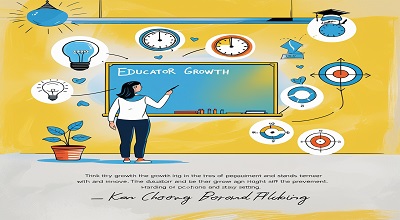Educator Growth Strategies
Educator Growth Strategies: The field of education is constantly evolving, requiring educators to adapt and grow continuously. Educator growth is not just about improving teaching skills but also about fostering a mindset of lifelong learning. This article explores the latest strategies for educator growth, supported by real-world examples, to help teachers and educational leaders enhance their professional development.
Why Educator Growth is Essential?
Educator growth is crucial for several reasons:
- Improves Student Outcomes: Well-trained teachers directly impact student achievement.
- Keeps Educators Updated: New teaching methodologies, technologies, and curricula require continuous learning.
- Boosts Job Satisfaction: Professional growth leads to higher engagement and reduced burnout.
- Encourages Innovation: Educators who grow professionally bring fresh ideas into the classroom.
Key Educator Growth Strategies
Continuous Professional Development (CPD)
CPD involves structured learning to enhance teaching skills. Examples include:
- Online Courses: Platforms like Coursera, edX, and Teach Educator offer courses on pedagogy.
- Micro-credentials: Short certifications in specialized areas (e.g., Google Certified Educator).
Peer Collaboration and Mentoring
- Professional Learning Communities (PLCs): Teachers collaborate to discuss best practices.
- Mentorship Programs: Experienced educators guide new teachers (e.g., New Teacher Center programs).
Leveraging Technology for Learning
- AI-Powered Tools: Adaptive learning platforms like Khan Academy.
- Virtual Reality (VR): Immersive history or science lessons.
Reflective Teaching Practices
- Journaling: Keeping a teaching journal to analyze lessons.
- Video Self-Assessment: Recording and reviewing classroom sessions.
Engaging in Educational Research
- Action Research: Conducting classroom-based studies to improve teaching.
- Publishing Findings: Sharing insights in journals or blogs.
Attending Workshops and Conferences
- ISTE Conference: Focuses on edtech innovations.
- ASCD Conferences: Covers leadership and curriculum development.
Pursuing Advanced Degrees and Certifications
- Master’s in Education (M.Ed.): Deepens subject expertise.
- National Board Certification: Recognizes teaching excellence.
Building a Professional Learning Network (PLN)
- Social Media: Twitter chats (#EdChat), LinkedIn groups.
- Webinars & Podcasts: Following education thought leaders.
Examples of Successful Educator Growth Initiatives
- Singapore’s Teacher Growth Model: Focuses on mentorship and structured CPD.
- Finland’s Collaborative Learning Culture: Teachers co-plan lessons and share feedback.
- Google for Education Certifications: Helps teachers integrate tech into classrooms.
Challenges in Educator Growth and How to Overcome Them
| Challenge | Solution |
|---|---|
| Time Constraints | Micro-learning (short, focused sessions) |
| Limited Funding | Free online resources (OER Commons) |
| Resistance to Change | Encouraging a growth mindset |
Future Trends in Educator Professional Development
- AI-Driven Personalized PD: Customized learning paths for teachers.
- Gamification of Learning: Badges and rewards for skill mastery.
- Global Teacher Collaborations: Cross-border professional networks.
Conclusion
Educator growth is a continuous journey that enhances teaching quality and student success. By adopting the latest strategies—such as CPD, peer collaboration, and tech integration—teachers can stay ahead in an ever-changing educational landscape.
FAQs
Q1: What is the most effective educator growth strategy?
A: A combination of CPD, peer mentoring, and reflective teaching yields the best results.
Q2: How can teachers find free professional development resources?
A: Websites like Teach Educator, Coursera (free courses), and OER Commons offer no-cost PD materials.
Q3: How often should educators engage in professional growth activities?
A: Ideally, teachers should dedicate at least 5-10 hours per month to professional learning.
Q4: Can technology replace traditional professional development?
A: No, but it enhances PD by providing flexible, on-demand learning opportunities.
Q5: What role do school leaders play in educator growth?
A: They should provide funding, time, and a supportive culture for continuous learning.
Free Download: XAPK Installer APK
